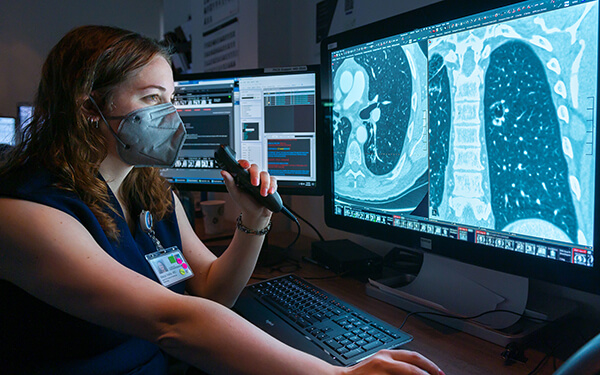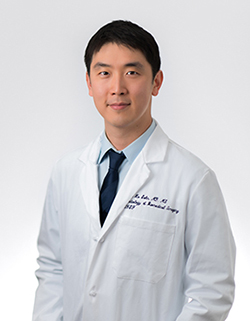The Future of AI and Lung Cancer Screening, A Conversation with Jae Ho Sohn, MD, MS

The primary purpose of lung cancer screening is to analyze the high-risk patient population to catch signs of cancer early. Jae Ho Sohn, MD, MS, assistant professor in the Cardiac and Pulmonary Imaging Section in the UC San Francisco Department of Radiology and Biomedical Imaging is engaged in a number of research projects including lung cancer risk stratification in lung cancer screening. He says that the field is moving toward a much needed risk based and personalized approach to lung cancer screening.
“As a radiologist and an artificial intelligence (AI) researcher, we're trying to integrate the baseline -- the first lung cancer screening scan that patients get -- and use that information,” says Dr. Sohn. “Then integrate that into the risk stratification and say, ‘Should we continue scanning this patient every year?’ Or should we potentially skip to every three years or every five years? Those are the questions we’re trying to answer.”
Some patients, despite annual scanning, have a poor prognosis because they are so high-risk. Dr. Sohn says these patients may need to be scanned every six months, or at minimum, have a primary care physician or pulmonologist follow up to make sure they're closely watched.
“We can apply an AI algorithm to the imaging at the baseline lung cancer screening. From there we’re hoping that we'll be able to have a more precise risk stratification showing patient probability for developing lung cancer, in order to be able to provide better care,” says Dr. Sohn.
 Dr. Sohn’s research also focuses on using both traditional machine learning as well as deep learning to help with more precise risk stratification for indeterminant nodules. He describes indeterminant nodules as those captured by computed tomography (CT) that are that are not definitively cancer. “Depending on the level of risk, a patient may end up being recommended for a lung biopsy, which carries, obviously, a procedural risk, as well as pain to the patient versus something that's a little bit less invasive, like a follow up CT scan. This is a place where I think AI can and will play an important role,” he says.
Dr. Sohn’s research also focuses on using both traditional machine learning as well as deep learning to help with more precise risk stratification for indeterminant nodules. He describes indeterminant nodules as those captured by computed tomography (CT) that are that are not definitively cancer. “Depending on the level of risk, a patient may end up being recommended for a lung biopsy, which carries, obviously, a procedural risk, as well as pain to the patient versus something that's a little bit less invasive, like a follow up CT scan. This is a place where I think AI can and will play an important role,” he says.
Overall, a risk stratification approach to lung cancer screening can reduce the number of unnecessary biopsies. This starts with research into having a better understanding of lung nodules. Beyond radiology and biomedical imaging, Dr. Sohn says some investigators in the research community are working to integrate blood based or genetic based biomarkers into lung cancer risk stratification. “As the field improves our understanding of those at highest risk for lung cancer, we will be able to target the lung cancer screening to those most in need,” says Dr. Sohn.
Risk based stratification is also important due to insurance coverage. “Those who do not meet the lung cancer screening criteria by just a tiny margin may not be offered lung cancer screening, and their insurance will not cover it,” says Dr. Sohn.
The U.S. Preventive Care Services Task Force (USPSTF) recently updated their guidance for CT lung cancer screening, and it is this criterion that most insurance companies use to make this determination. This 2021 guidance reduced the starting age for CT lung cancer screening from 55 to 50 and adjusted smoking history from 30 pack years to 20 pack years.
“What we are finding, however, is that people are not smoking like they used to, but there are still groups who are at higher risk for lung cancer despite having never smoked,” explains Dr. Sohn. “For example, we know women have a higher risk for lung adenocarcinoma. Certain racial or ethnic groups are also at high risk, such as the Asian population being at an elevated risk for lung adenocarcinoma. There are also additional risk factors such as exposure to certain chemicals and family history of lung cancer. So, criteria that is currently based only on smoking and age is inadequate.”
Keeping all of this in mind, and as our understanding of epidemiology and our use of AI algorithms get more precise and better, we can better target screening to those who are truly at risk.
